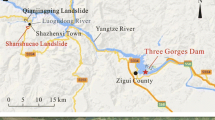Abstract
At 00:20 on 21 October 2017, a large landslide occurred in Guang’an Village, Wuxi County, Chongqing, China. The overall length of the landslide was approximately 1500 m, the width was approximately 1300 m, the distribution area was approximately 1.95 km2, and the total volume was approximately 24.8 million m3, with volume of the slipped area being approximately 6 million m3. Nine people were reported missing after the landslide deposits accumulated in the riverbed of the Xixi River and blocked approximately 160 m of the river, forming a dammed lake. We investigated the cause and mechanism of the initiation and development of the landslide using field investigations and on-site monitoring. The formation process of landslides can be divided into three stages: the start-up stage of the rock avalanche, the transportation stage, and the accumulation stage. In this case, the strength of the upper limestone was much greater than the strength of the lower shale. Under the effect of groundwater softening, the lower shale was plastically deformed with the combination of weak and hard lithologies, resulting in a rapid slip of the upper rock mass under gravity. After the slip of the rock mass in the source area, the rock mass of the lower slope was pushed downward. Then, the sliding mass moved from the source area pushing through the transportation area and formed the depositional area. There is still a possibility of further slip, so preventive measures must be taken as soon as possible to manage the potential slippage.










Similar content being viewed by others
References
Deng M, Xu Q, Han B, Zhu X, Cai G, Zheng G (2014) The microscopic structure and rheological characteristics of the slip zone soft rock of Jiweishan landslide in Wulong of Chongqing: China. Mt Res 32:233–240 (in Chinese)
Fan X, Xu Q, Scaringi G, Dai L, Li W, Dong X, Zhu X, Pei X, Dai K, Havenith H-B (2017) Failure mechanism and kinematics of the deadly June 24th 2017 Xinmo landslide, Maoxian, Sichuan, China. Landslides 14(6):2129–2146
Hungr O, Leroueil S, Picarelli L (2014) The Varnes classification of landslide types, an update. Landslides 11(2):167–194
Scaringi G, Fan X, Xu Q, Liu C, Ouyang C, Domènech G, Yang F, Dai L (2018) Some considerations on the use of numerical methods to simulate past landslides and possible new failures: the case of the recent Xinmo landslide (Sichuan, China). Landslides 15(7):1359–1375
Tang H, Zou Z, Xiong C, Wu Y, Hu X, Wang L, Lu S, Criss RE, Li C (2014) An evolution model of large consequent bedding rockslides, with particular reference to the Jiweishan rockslide in Southwest China. Eng Geol 186:17–27
Wang Y, Zhao B, Li J (2017) Mechanism of the catastrophic June 2017 landslide at Xinmo Village, Songping River, Sichuan Province, China. Landslides 15(2):333–345
Yin Y (2010) Mechanism of apparent dip slide of inclined bed-ding rockslide-a case study of Jiweishan rock slide in Wulong, Chongqing. Chin J Rock Mech Eng 29(2):217–226
Yin Y, Pan G, Liu Y et al (2009) Great Wenchuan earthquake: Seismogeology and landslide hazards. Geological Publishing House, Beijing (in Chinese)
Yin YP, Cheng YL, Liang JT, Wang WP (2016) Heavy-rainfall-induced catastrophic rockslide-debris flow at Sanxicun, Dujiangyan, after the Wenchuan Ms 8.0 earthquake. Landslides 13(1):9–23
Yin, Yueping, Wang, Wenpei, Zhang, Nan, Yan, Jingkai, Wei, Yunjie, And Yang, Longwei (2017) Long runout geological disaster initiated by the ridge-top rockslide in a strong earthquake area: a case study of the Xinmo landslide in Maoxian County, Sichuan Province. Geol China 44(5):827~841
Zhang M, McSaveney MJ (2018) Is air pollution causing landslides in China? Earth Planet Sci Lett 481:284–289
Zhang M, Yin Y (2013) Dynamics, mobility-controlling factors and transport mechanisms of rapid long-runout rock avalanches in China. Eng Geol 167(2013):37–58
Funding
This study is supported by the project on Reconnaissance and Research by China Geological Survey (Grant No. DD20179609) and the study on the Long-Term Strength Weakening Law and Protection Measures of the Yangtze River in Chongqing Reservoir Area of the Three Gorges.
Author information
Authors and Affiliations
Corresponding author
Rights and permissions
About this article
Cite this article
Wang, L., Yin, Y., Huang, B. et al. Formation and characteristics of Guang’an Village landslide in Wuxi, Chongqing, China. Landslides 16, 127–138 (2019). https://doi.org/10.1007/s10346-018-1086-x
Received:
Accepted:
Published:
Issue Date:
DOI: https://doi.org/10.1007/s10346-018-1086-x




